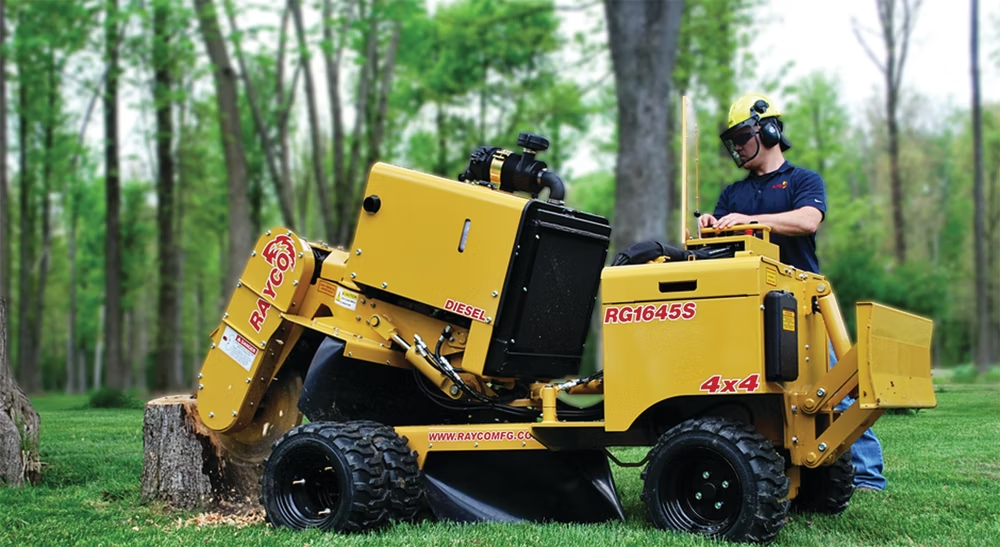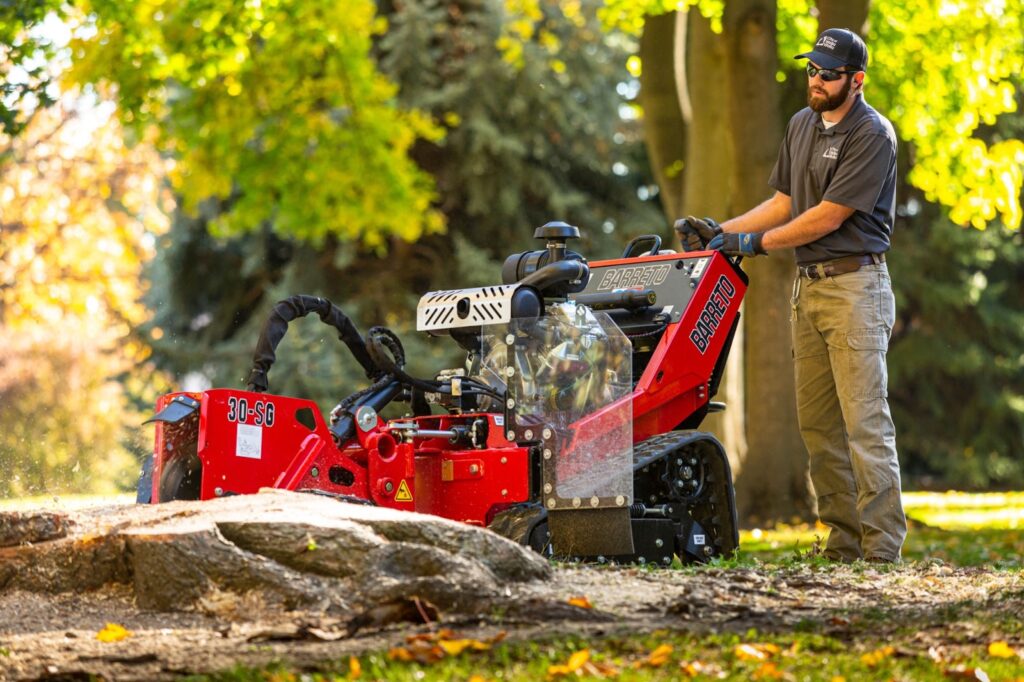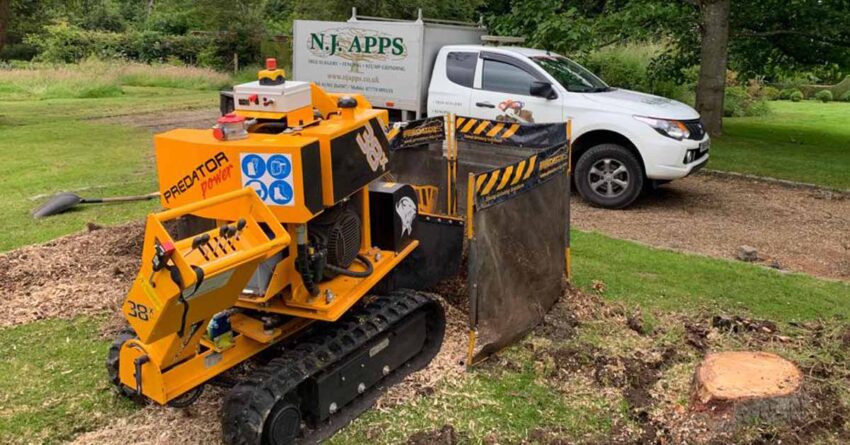In any backyard landscaping project, it is common to encounter unwanted stumps that not only pose a safety hazard but also hinder the overall aesthetics of the outdoor space. Fortunately, stump grinding offers a safe and effective solution to remove these eyesores. This article will guide you through the various aspects of backyard stump grinding, including understanding the basics, implementing safety measures, selecting the right equipment, and following a step-by-step guide for a successful grinding process. Additionally, we will discuss the importance of post-grinding cleanup and maintenance to ensure a clean and well-maintained yard.
Understanding the Basics of Stump Grinding
The first step in any stump grinding project is to understand what exactly stump grinding entails and why it is necessary.
Stump grinding is not just a practical solution for removing unsightly tree stumps; it is also an environmentally friendly option. When stumps are left to decay naturally, they can release carbon dioxide into the atmosphere, contributing to greenhouse gas emissions. By grinding the stump and speeding up the decomposition process, you are helping to reduce your carbon footprint.
What is Stump Grinding?
Stump grinding is the process of using a specialized machine called a stump grinder for tree root removal or stumps removal from the ground. The grinder consists of a rotating cutting disk that grinds the stump and its roots into small wood chips.
During the stump grinding process, the machine grinds the stump to a specific depth, usually 6-12 inches below the ground. This ensures that the entire stump, along with its major roots, is effectively removed, preventing any potential regrowth in the future.
Why is Stump Grinding Necessary?
Stumps left behind after tree removal can be unsightly and are potential tripping hazards. Additionally, stumps can attract pests and promote the growth of fungi and bacteria. By grinding the stump, you eliminate these risks and create a smooth and safe environment in your backyard.
Moreover, by removing the stump, you free up space in your yard for landscaping or construction projects. Whether you want to plant a new tree, install a garden, or build a patio, getting rid of the stump is the first step towards transforming your outdoor space into a functional and aesthetically pleasing area.
Safety Measures for Stump Grinding
Prioritizing safety is crucial when undertaking any stump grinding project. Here are some essential safety measures to follow:
Stump grinding can be a hazardous task if not approached with caution and the right safety measures. It is important to remember that safety should always come first to prevent any potential accidents or injuries during the process.
Personal Protective Equipment for Stump Grinding
When operating a stump grinder, it is important to wear protective gear such as safety goggles, ear muffs, and a hard hat to safeguard yourself from flying debris and loud noises.
Protective equipment is not just a recommendation but a necessity when it comes to stump grinding. The noise levels generated by the grinder can be harmful to your hearing, and debris flying around can pose a risk to your eyes and head. Ensuring you have the right gear on before starting the machine is crucial for your safety.
Pre-Grinding Safety Checks
Before starting the grinding process, ensure the area is clear of any obstacles or debris that may interfere with the machine’s operation. Additionally, visually inspect the grinder for any damages or mechanical issues that could compromise safety.
Conducting thorough pre-grinding safety checks is a fundamental step in ensuring a safe working environment. Clearing the area of any potential hazards not only protects you but also prevents damage to the equipment. A visual inspection of the grinder is essential to identify any issues that could lead to malfunctions during operation, reducing the risk of accidents.
Choosing the Right Stump Grinder
Selecting the appropriate stump grinder is crucial for the success of your project. Consider the following factors when making your choice:
When embarking on a stump removal project, it is essential to delve deeper into the world of stump grinders to make an informed decision. Beyond just the types of stump grinders available, it is important to understand the intricacies of each option to ensure optimal results.
Types of Stump Grinders
There are various types of stump grinders available, including handheld grinders, self-propelled grinders, and tow-behind grinders. The size of your project and accessibility of the stumps will determine which type is most suitable for your needs.
Handheld stump grinders offer portability and ease of maneuverability in tight spaces, making them ideal for small-scale projects. On the other hand, self-propelled grinders provide more power and efficiency, suitable for larger stumps and extensive projects. Meanwhile, tow-behind grinders are perfect for heavy-duty tasks, offering high cutting capacity and stability.

Factors to Consider When Choosing a Stump Grinder
Factors like power, cutting depth, maneuverability, and ease of maintenance should be considered when selecting a stump grinder. Additionally, ensure that the size and weight of the grinder are manageable for your specific requirements.
Power is a crucial aspect to evaluate, as it determines the efficiency of the grinding process. Opt for a stump grinder with sufficient power to tackle the size and hardness of the stumps in your project. Cutting depth is another vital consideration, especially if you are dealing with older, larger stumps that require deeper penetration.
Step-by-Step Guide to Stump Grinding
Now that you have the necessary knowledge and equipment, let’s delve into the step-by-step process of stump grinding:
Preparing the Stump for Grinding
Start by clearing the area around the stump, removing any rocks, twigs, or other debris that could damage the grinder. This step is crucial to ensure a smooth and efficient grinding process. By creating a clean workspace, you minimize the risk of obstructions interfering with the grinder’s operation. Additionally, removing obstacles around the stump enhances safety for both you and the equipment.
Trim the stump as close to the ground as possible using a chainsaw or a handsaw. This initial cut helps reduce the overall workload for the stump grinder and facilitates a more precise grinding process. Be mindful of any protruding roots or uneven surfaces that may impede the grinder’s movement.
Next, position the stump grinder so that the cutting disk is directly above the center of the stump. Proper alignment is key to effectively targeting the stump and achieving optimal grinding results. Adjust the height and angle of the grinder according to the size and shape of the stump. This customization ensures thorough grinding and helps prevent unnecessary strain on the equipment.
The Grinding Process
Begin the grinding process by engaging the cutting disk and slowly lowering it onto the stump. Exercise caution and maintain a steady hand to control the grinder’s movements. As the grinding action commences, observe the stump’s gradual transformation into wood chips. The rhythmic back-and-forth motion of the disk is instrumental in breaking down the stump and its interconnected roots.
Move the disk from side to side and carefully grind the stump and its roots. Pay close attention to any resistance or changes in grinding sound, as these indicators can signal varying densities within the stump. Take breaks periodically to allow the machine to cool down and prevent overheating. Monitoring the grinder’s temperature ensures its longevity and sustained performance throughout the grinding process.
Continue grinding until the stump is completely ground down and only wood chips remain. Achieving a level surface devoid of any remnants signifies the successful completion of the grinding task. Use a shovel or rake to clear away the wood chips and inspect the area for any remaining debris. Thoroughly survey the surroundings to confirm the absence of hidden roots or debris that may impede future landscaping endeavors.
Post-Grinding Cleanup and Maintenance
Completing the grinding process is not the end of your backyard stump removal journey. Proper cleanup and maintenance are essential for a pristine outdoor space.
Once the stump is fully ground, remove all wood chips and leftover debris from the area. Dispose of the waste responsibly or repurpose it as mulch for your garden beds. It’s important to ensure that the area is clear of any potential hazards and that the ground is level to prevent any tripping or mowing accidents.
Additionally, consider adding a layer of topsoil over the area where the stump used to be to promote healthy grass growth and prevent any uneven patches in your lawn. This extra step can help seamlessly blend the previously occupied space with the rest of your yard, enhancing its overall appearance.
Cleaning Up After Stump Grinding
Once the stump is fully ground, remove all wood chips and leftover debris from the area. Dispose of the waste responsibly or repurpose it as mulch for your garden beds.
When cleaning up after stump grinding, pay attention to any roots that may still be lingering underground. These roots can be a tripping hazard and may hinder future landscaping projects. Consider using a root barrier to prevent any regrowth and to protect the surrounding plants and structures.

Maintaining Your Stump Grinder
After each use, clean the stump grinder thoroughly to remove any wood residue. Inspect the machine for any damages and perform regular maintenance tasks, such as lubrication and blade sharpening, to keep it in optimal condition.
Proper maintenance of your stump grinder is crucial for its longevity and performance. Regularly check the engine oil levels, air filters, and belts to ensure everything is in working order. Keeping your equipment well-maintained not only extends its lifespan but also ensures safe operation during future stump removal projects.
By following these safe and effective methods for backyard stump grinding, you can transform your outdoor space into a clean and inviting environment. Remember to prioritize safety, choose the right grinder, and maintain the equipment to ensure a successful stump removal project.

